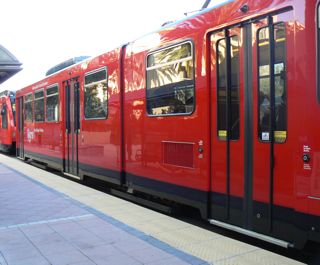When faced with the costs and logistics of rail, planners and city officials increasingly seem to favor Bus Rapid Transit (BRT), a trend likely to continue through the current recession. But even with the many persuasive arguments for BRT, the nagging question remains: why not rail?
When faced with the costs and logistics of rail, planners and city officials increasingly seem to favor Bus Rapid Transit (BRT), a trend likely to continue through the current recession. But even with the many persuasive arguments for BRT, the nagging question remains: why not rail?
 To be successful, a rapid transit system needs to be comprehensive. Either a city is going to invest in comprehensive BRT (like Brisbane or Bogota), a comprehensive rail network (like Toronto, New York, or European metropolitan rail systems), or a mix of rail and BRT. The halfway approach doesn't do the job.
To be successful, a rapid transit system needs to be comprehensive. Either a city is going to invest in comprehensive BRT (like Brisbane or Bogota), a comprehensive rail network (like Toronto, New York, or European metropolitan rail systems), or a mix of rail and BRT. The halfway approach doesn't do the job.
The limited experiments with BRT in the United States have so far amounted to "light rail lite": single corridor bus lines that attempt to mimic light rail. Transportation experts Alan Hoffman and Alasdair Cain argue that significant infrastructure investments - in the form of separated guideways called ‘Quickways' - are needed before American cities can achieve the ridership and efficiency of the world's best BRT.
Similarly, light rail ridership suffers because established networks do not yet cover enough ground. In southern California, the Los Angeles Metro and the San Diego Trolley do not reach most residential neighborhoods, tourist destinations or satellite cities, let alone suburban job centers. (The good news is that these systems are expanding, albeit slowly). Rail stops can also be located in disconnected, unwalkable areas.
If a city is serious about mass transit, it will require substantial capital and a fairly bold vision to implement either BRT or rail (light rail or the uber-expensive heavy rail subway). The most persuasive argument for Bus Rapid Transit is that it can be established more quickly and at lower cost. BRT can also use existing automobile infrastructure like wide roads and freeways. Furthermore, because buses are more flexible than fixed rail, they can leave the busway to access out-of-the way housing developments and office parks. In other words, BRT better serves sprawl, which after all is what shapes most American metropolitan areas.
Still, for riders, skepticism about BRT persists. Will it be as sleek and comfortable as a train? Can one read on a bus, even a modern one? Is the experience a vast improvement over a bumpy city bus? Will it be slowed by car traffic? Given the infrastructure required for true BRT, why not simply pursue rail? Elevated busways can look a lot like freeways – how will they affect neighborhoods?
If a modern rail system seems impossible, Toronto presents a good case for investment in higher quality rail, even if that means diverting funds from other modes (i.e., roads and highways). The city opened its first subway in 1954, added two more lines, integrated subways with retained streetcar lines, and more recently supplemented with above-ground light rail. It is not a coincidence that subways were expanded as several freeway projects were canceled.
So, transit riders and planners, for your city would you choose rail, BRT or a combination of both?

Alabama: Trump Terminates Settlements for Black Communities Harmed By Raw Sewage
Trump deemed the landmark civil rights agreement “illegal DEI and environmental justice policy.”

Planetizen Federal Action Tracker
A weekly monitor of how Trump’s orders and actions are impacting planners and planning in America.

The 120 Year Old Tiny Home Villages That Sheltered San Francisco’s Earthquake Refugees
More than a century ago, San Francisco mobilized to house thousands of residents displaced by the 1906 earthquake. Could their strategy offer a model for the present?

Housing Vouchers as a Key Piece of Houston’s Housing Strategy
The Houston Housing Authority supports 19,000 households through the housing voucher program.

Rural Population Grew Again in 2024
Americans continued to move to smaller towns and cities, resulting in a fourth straight year of growth in rural areas.

Safe Streets Grants: What to Know
This year’s round of Safe Streets for All grant criteria come with some changes.
Urban Design for Planners 1: Software Tools
This six-course series explores essential urban design concepts using open source software and equips planners with the tools they need to participate fully in the urban design process.
Planning for Universal Design
Learn the tools for implementing Universal Design in planning regulations.
Clanton & Associates, Inc.
Jessamine County Fiscal Court
Institute for Housing and Urban Development Studies (IHS)
City of Grandview
Harvard GSD Executive Education
Toledo-Lucas County Plan Commissions
Salt Lake City
NYU Wagner Graduate School of Public Service




























